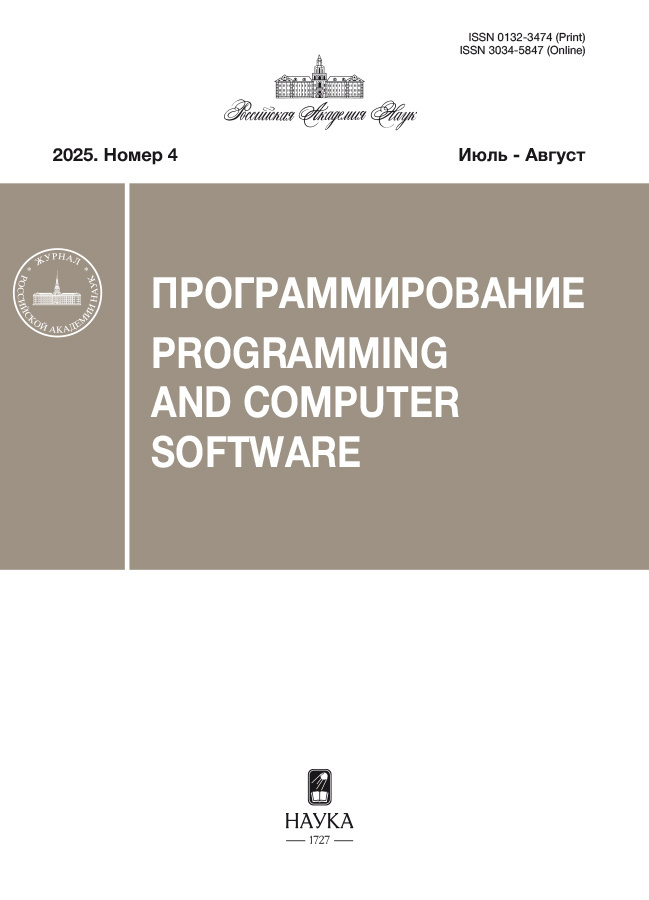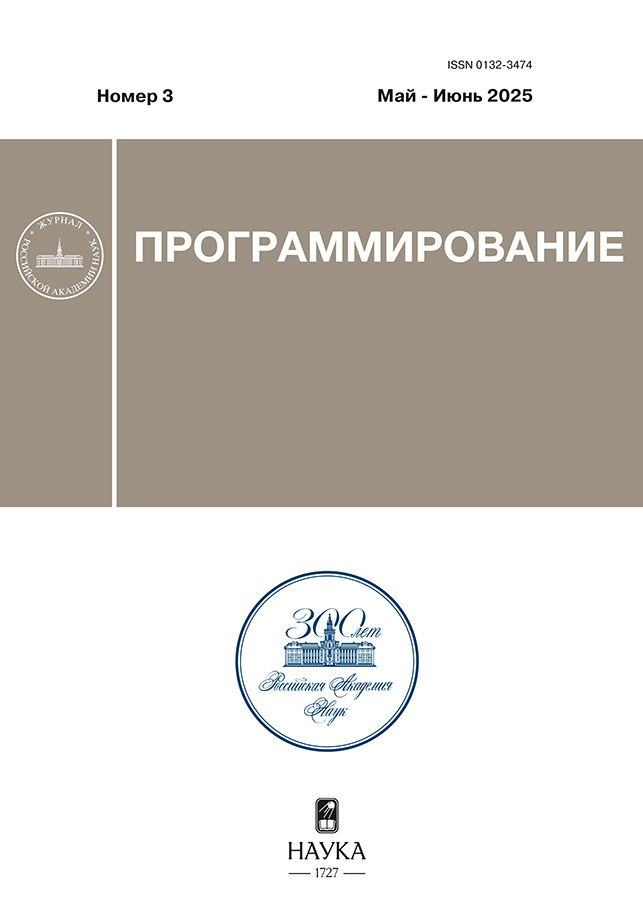Study of surface representation methods based on signed distance functions
- Authors: Garifullin A.R.1, Frolov V.A.2,1,3, Budak A.S.2,3, Galaktionov V.A.4
-
Affiliations:
- Keldysh Institute of Applied Mathematics, Russian Academy of Sciences 4 Miusskaya Square
- Institute of Artificial Intelligence, Moscow State University Leninskie Gory
- Moscow State University Leninskie Gory Faculty of Computational Mathematics and Cybernetics
- Keldysh Institute of Applied Mathematics, Russian Academy of Sciences
- Issue: No 3 (2025)
- Pages: 15–26
- Section: COMPUTER GRAFICS AND VISUALIZATION
- URL: https://journals.eco-vector.com/0132-3474/article/view/688100
- DOI: https://doi.org/10.31857/S0132347425030027
- EDN: https://elibrary.ru/GQQQOR
- ID: 688100
Cite item
Abstract
The paper studies surface rendering methods based on ray tracing for representations based on signed distance functions. The main objects of interest were the rendering algorithm execution time, the amount of memory occupied, and the accuracy of the surface representation estimated by the render using the PSNR metric. Six different representations and four intersection search algorithms were analyzed. In all cases, a bounding volume hierarchy was used as an accelerating structure. The comparison revealed promising representations and algorithms and showed that distance functions in some cases are not inferior to polygonal models in speed, while they can win in terms of memory consumption and represent the surface with a good level of accuracy.
Full Text
About the authors
A. R. Garifullin
Keldysh Institute of Applied Mathematics, Russian Academy of Sciences 4 Miusskaya Square
Author for correspondence.
Email: albert.garifullin@gin.keldysh.ru
ORCID iD: 0000-0001-5385-4841
Russian Federation, Moscow, 125047
V. A. Frolov
Institute of Artificial Intelligence, Moscow State University Leninskie Gory; Keldysh Institute of Applied Mathematics, Russian Academy of Sciences 4 Miusskaya Square; Moscow State University Leninskie Gory Faculty of Computational Mathematics and Cybernetics
Email: vladimir.frolov@graphics.cs.msu.ru
ORCID iD: 0000-0001-8829-9884
Russian Federation, Moscow, 119899; Moscow, 125047; Moscow, 119899
A. S. Budak
Institute of Artificial Intelligence, Moscow State University Leninskie Gory; Moscow State University Leninskie Gory Faculty of Computational Mathematics and Cybernetics
Email: s02220347@gse.cs.msu.ru
ORCID iD: 0009-0005-6819-4184
Russian Federation, Moscow, 119899; Moscow, 119899
V. A. Galaktionov
Keldysh Institute of Applied Mathematics, Russian Academy of Sciences
Email: vlgal@gin.keldysh.ru
ORCID iD: 0000-0003-1252-8294
Russian Federation, 4 Miusskaya Square, Moscow, 125047
References
- Rogers D.F. An Introduction to NURBS: With Historical Perspective, Elsevier, 2000.
- Sitzmann V., Martel J., Bergman A., Lindell D., Wetzstein G. Implicit neural representations with periodic activation functions, Advances in Neural Information Processing Systems, Larochelle H., Ranzato M., Hadsell R., Balcan M.F., and Lin H., Eds., Curran Associates, 2020, vol. 33, pp. 7462–7473. https://proceedings.neurips.cc/paper_files/paper/2020/file/53c04118df112c13a8c34b38343b9c10-Paper.pdf
- Takikawa T., Litalien J., Yin K., Kreis K., Loop Ch., Nowrouzezahrai D., Jacobson A., Mcguire M., Fidler S. Neural geometric level of detail: Real-time rendering with implicit 3d shapes, 2021 IEEE/CVF Conference on Computer Vision and Pattern Recognition (CVPR), Nashville, TN, 2021, IEEE, 2021, pp. 11358–11367. https://doi.org/10.1109/cvpr46437.2021.01120
- Luan F., Zhao Sh., Bala K., Dong Zh. Unified shape and SVBRDF recovery using differentiable Monte Carlo rendering, Comput. Graphics Forum, 2021, vol. 40, no. 4, pp. 101–113. https://doi.org/10.1111/cgf.14344
- Nicolet B., Jacobson A., Jakob W. Large steps in inverse rendering of geometry, ACM Trans. Graphics, 2021, vol. 40, no. 6, p. 248. https://doi.org/10.1145/3478513.3480501
- Vicini D., Speierer S., Jakob W. Differentiable signed distance function rendering, ACM Trans. Graphics, 2022, vol. 41, no. 4, p. 125. https://doi.org/10.1145/3528223.3530139
- Cao Yu., Li H. DiffSDF: Learning implicit surface from noisy point clouds, 2023 International Conference on Digital Image Computing: Techniques and Applications (DICTA), Port Macquarie, Australia, 2023, IEEE, 2023, pp. 197–204. https://doi.org/10.1109/DICTA60407.2023.00035
- Hart J.C. Sphere tracing: A geometric method for the antialiased ray tracing of implicit surfaces, Visual Comput., 1996, vol. 12, no. 10, pp. 527–545. https://doi.org/10.1007/s003710050084
- Quilez I. Distance functions. https://iquilezles.org/articles/distfunctions/ (сited June 12, 2024)
- Quilez I. Raymarching terrain. https://iquilezles.org/articles/terrainmarching/ (сited June 12, 2024)
- Polkowski D. San Base: Forefront of computer graphics. https://www.youtube.com/@lashenko (сited June 12, 2024)
- Frisken S.F., Perry R.N., Rockwood A.P., Jones T.R. Adaptively sampled distance fields: A general representation of shape for computer graphics, Proceedings of the 27th Annual Conference on Computer Graphics and Interactive Techniques, New Orleans, 2000, New York: ACM Press/Addison-Wesley, 2000, pp. 249–254. https://doi.org/10.1145/344779.344899
- Sellers G., Kessenich J. Vulkan Programming Guide: The Official Guide to Learning Vulkan, Addison–Wesley, 2016.
- Koschier D., Deul C., Brand M., Bender J. An hp-adaptive discretization algorithm for signed distance field generation, IEEE Trans. Visualization Comput. Graphics, 2017, vol. 23, no. 10, pp. 2208–2221. https://doi.org/10.1109/tvcg.2017.2730202
- Söderlund H.H., Evans A., Akenine-Möller T. Ray tracing of signed distance function grids, Journal of Computer Graphics Techniques, 2022, vol. 11, no. 3, pp. 94–113.
- Fujimoto A., Iwata K. Accelerated ray tracing, Computer Graphics, Kunii T.L., Ed., Tokyo: Springer, 1985, pp. 41–65. https://doi.org/10.1007/978-4-431-68030-7_4
- Weier P., Rath A., Michel É., Georgiev I., Slusallek P., Boubekeur T. N-BVH: Neural ray queries with bounding volume hierarchies, Special Interest Group on Computer Graphics and Interactive Techniques Conference Conference Papers’24, Denver, CO, 2024, Burbano A., Zorin D., and Jarosz W., Eds., New York: Association for Computing Machinery, 2024, p. 99. https://doi.org/10.1145/3641519.3657464
- Fujieda S., Kao C.C., Harada T. Neural intersection function, High-Performance Graphics – Symposium Papers, Bikker J. and Gribble Ch., Eds., The Eurographics Association, 2023. https://doi.org/10.2312/hpg.20231135
- Galin E., Guérin E., Paris A., Peytavie A. Segment tracing using local Lipschitz bounds, Comput. Graphics Forum, 2020, vol. 39, no. 2, pp. 545–554. https://doi.org/10.1111/cgf.13951
- Marmitt G., Kleer A., Friedrich H., Wald I., Slusallek P. Fast and accurate ray-voxel intersection techniques for iso-surface ray tracing, Proceedings of the Vision, Modeling, and Visualization Conference (VMV 2004), Stanford, CA, 2004, vol. 4, pp. 429–435.
- Stich M., Friedrich H., Dietrich A. Spatial splits in bounding volume hierarchies, Proceedings of the Conference on High Performance Graphics 2009, New Orleans, 2009, Spencer S.N., McAllister D., Pharr M., and Wald I., Eds., New York: Association for Computing Machinery, 2009, pp. 7–13. https://doi.org/10.1145/1572769.1572771
- Wald I., Woop S., Benthin C., Johnson G.S., Ernst M. Embree: A kernel framework for efficient CPU ray tracing, ACM Trans. Graphics, 2014, vol. 33, no. 4, p. 143. https://doi.org/10.1145/2601097.2601199
- Frolov V., Sanzharov V., Galaktionov V. Kernel_slicer: High-level approach on top of GPU programming API, 2022. Ivannikov Ispras Open Conference (ISPRAS), Moscow, 2022, IEEE, 2022, pp. 11–17. https://doi.org/10.1109/ispras57371.2022.10076850
- Zhdanov D.D., Potemin I.S., Zhdanov A.D. Embree technology for ray tracing in optical systems with free shape surfaces, Trudy 33-i Mezhdunarodnoi konferentsii po komp’yuternoi grafike i mashinnomu zreniyu GrafiKon 2023 (Proceedings of the 33rd International Conference on Computer Graphics and Machine Visiton GraphiCon2023), Moscow: Institut Prikladnoi Matematiki im. M.V. Keldysha Rossiiskoi Akademii Nauk, 2023, vol. 33, pp. 97–107. https://doi.org/10.20948/graphicon-2023-97-107
- Jones M.W. Distance field compression, J. WSCG, 2004, vol. 12, no. 2, pp. 199–204.
- Nießner M., Zollhöfer M., Izadi Sh., Stamminger M. Real-time 3D reconstruction at scale using voxel hashing, ACM Trans. Graphics, 2013, vol. 32, no. 6, p. 169. https://doi.org/10.1145/2508363.2508374
- Boyko A.I., Matrosov M.P., Oseledets I.V., Tsetserukou D., Ferrer G. TT-TSDF: Memory-efficient TSDF with low-rank tensor train decomposition, 2020 IEEE/RSJ International Conference on Intelligent Robots and Systems (IROS), Las Vegas, 2020, IEEE, 2020, pp. 10116–10121. https://doi.org/10.1109/iros45743.2020.9341464
- Garland M., Heckbert P.S. Surface simplification using quadric error metrics, Seminal Graphics Papers: Pushing the Boundaries, Volume 2, Whitton M.C., Ed., New York: Association for Computing Machinery, 2023, vol. 2, p. 15. https://doi.org/10.1145/3596711.3596727
Supplementary files














